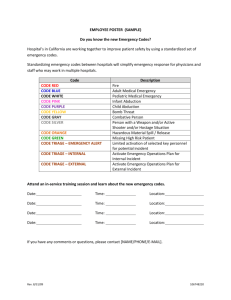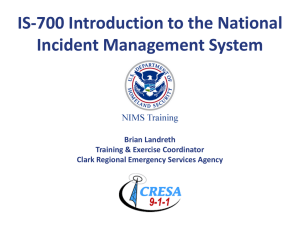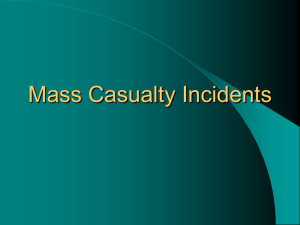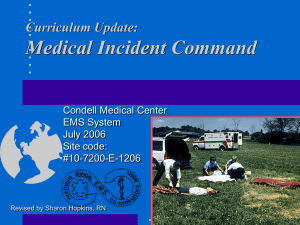AEMT Transition - Unit 48
advertisement
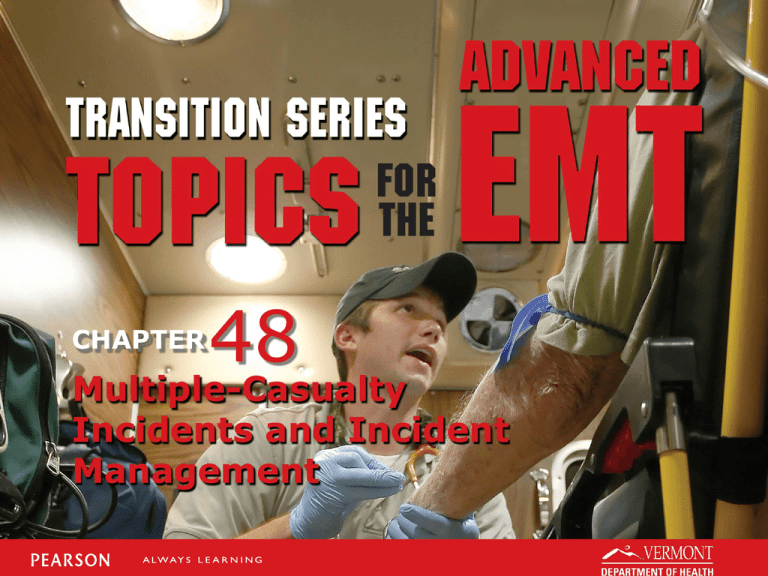
TRANSITION SERIES Topics for the Advanced EMT CHAPTER 48 Multiple-Casualty Incidents and Incident Management Objectives • Review what an MCI event is. • Discuss the NIMS framework. • Discuss how the ICS within NIMS is to be deployed during an MCI. • Review the START triage format. • Discuss the psychological stress that may arise in EMS secondary to an MCI. National Incident Management System • Components – Preparedness – Communication and Information Management – Resource Management – Command and Management – Ongoing Management and Maintenance Incident Command System • Designed to match complexities and demands of single or multiple events Incident Command System (cont’d) • Six major functional areas – Command – Operations – Planning – Logistics – Finance/Administration – Intelligence and Investigations The incident commander directs the response and coordinates resources. Wearing reflective vests makes it easier to identify personnel. Incident Command System (cont’d) • Branch units – Triage Primary and secondary Red, yellow, green, black – START triage Respiratory status, perfusion status, mental status Incident Command System (cont’d) • Treatment – Care based on priority – Safe distance from incident – May be more than one treatment area Patients are treated after triage, in order of priority. Incident Command System (cont’d) • Transport – Ensures ambulances are accessible – Coordinates with Incident Commander – Considers transport destinations, needs of the patients, volume, distance, etc. Incident Command System (cont’d) • Communications – A plan should be made prior to any incident. – Take into consideration things like terrain, capabilities, dead spots, channel gridlock, etc. Incident Command System (cont’d) • Follow-through – After transport to hospitals, EMS helps facilities in follow-through care. – Coordinated by the Incident Commander. Psychological Stress • Stress – May affect EMS providers. – Could happen during, after, or long after an event. – Relief efforts may help limit the effects of stress – There should be organized stress management plans and activities. Case Study • You are called to a local airstrip for a possible “plane down.” Normally this airstrip only handles small aircraft that carry 2-4 people. This time, however, a 16-passenger craft attempted an emergency landing due to engine failure and ran off the end of the runway. Case Study (cont’d) • As the first unit that will be arriving on scene, what concerns do you have? • What type of information about the aircraft do you need as soon as possible? Case Study (cont’d) • When you arrive, you see that the aircraft is upside down at the end of the runway. The right wing has been torn off and is burning about 500 feet away. There is smoke coming from the windows of the passenger compartment, but no open flames. As you draw near, you note that no fire suppression has arrived yet. Case Study (cont’d) • What will your actions be with this information? What will you do until the FD and additional support arrive? • With adequate personnel available, what branch sectors will need to be established? Case Study (cont’d) • What are the components of the START triage system? • What is the purpose of the “followthrough” at the conclusion of an MCI? Summary • Handling an MCI is a difficult task for most any EMS provider, even with proper education and preparation. • MCI drills often do not create the same stress and drama an actual event would, but the drill will expose strengths and weaknesses of the system. Summary (cont’d) • It is the responsibility of the EMT to remain abreast of NIMS, ICS, and START so as to be a functional part should an MCI occur.
